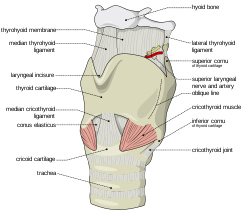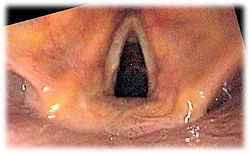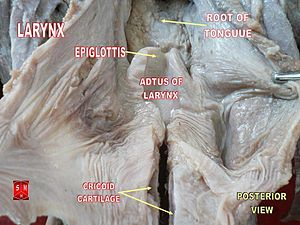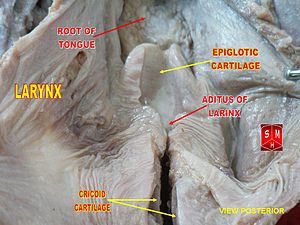- Larynx
-
For the remotely piloted vehicle, see Larynx (unmanned aircraft).
Larynx 
Anatomy of the larynx, anterolateral view 
Endoscopic image of larynx The larynx (plural larynges), commonly called the voice box, is an organ in the neck of amphibians, reptiles (incl. birds) and mammals[citation needed] (including humans) involved in breathing, sound production, and protecting the trachea against food aspiration. It manipulates pitch and volume. The larynx houses the vocal folds (commonly but improperly termed the "vocal cords"), which are essential for phonation. The vocal folds are situated just below where the tract of the pharynx splits into the trachea and the esophagus.
Contents
Anatomical position and description
In adult humans, the larynx is found in the anterior neck at the level of the C3–C6 vertebrae. It connects the inferior part of the pharynx (hypopharynx) with the trachea. The laryngeal skeleton consists of nine cartilages: three single (epiglottic, thyroid and cricoid) and three paired (arytenoid, corniculate, and cuneiform). The hyoid bone is not part of the larynx, though it is connected to it. The larynx extends vertically from the tip of the epiglottis to the inferior border of the cricoid cartilage. Its interior can be divided in supraglottis, glottis and subglottis.
In newborn infants, the larynx is initially at the level of the C2–C3 vertebrae, and is further forward and higher relative to its position in the adult body.[1] The larynx descends as the child grows.[2][3]
Function
Sound is generated in the larynx, and that is where pitch and volume are manipulated. The strength of expiration from the lungs also contributes to loudness.[4]
Fine manipulation of the larynx is used to generate a source sound with a particular fundamental frequency, or pitch. This source sound is altered as it travels through the vocal tract, configured differently based on the position of the tongue, lips, mouth, and pharynx. The process of altering a source sound as it passes through the filter of the vocal tract creates the many different vowel and consonant sounds of the world's languages as well as tone, certain realizations of stress and other types of linguistic prosody. The larynx also has a similar function as the lungs in creating pressure differences required for sound production; a constricted larynx can be raised or lowered affecting the volume of the oral cavity as necessary in glottalic consonants.
The vocal folds can be held close together (by adducting the arytenoid cartilages), so that they vibrate (see phonation). The muscles attached to the arytenoid cartilages control the degree of opening. Vocal fold length and tension can be controlled by rocking the thyroid cartilage forward and backward on the cricoid cartilage (either directly by contracting the cricothyroids or indirectly by changing the vertical position of the larynx), by manipulating the tension of the muscles within the vocal folds, and by moving the arytenoids forward or backward. This causes the pitch produced during phonation to rise or fall. In most males the vocal folds are longer and with a greater mass, producing a deeper pitch.
The vocal apparatus consists of two pairs of mucosal folds. These folds are false vocal folds (vestibular folds) and true vocal folds (folds). The false vocal folds are covered by respiratory epithelium, while the true vocal folds are covered by stratified squamous epithelium. The false vocal folds are not responsible for sound production, but rather for resonance. The exceptions to this are found in Tibetan Chant and Kargyraa, a style of Tuvan throat singing. Both make use of the false vocal folds to create an undertone. These false vocal folds do not contain muscle, while the true vocal folds do have skeletal muscle.
During swallowing, the backward motion of the tongue forces the epiglottis over the glottis' opening to prevent swallowed material from entering the larynx which leads to the lungs; the larynx is also pulled upwards to assist this process. Stimulation of the larynx by ingested matter produces a strong cough reflex to protect the lungs.
Innervation
The larynx is innervated by branches of the vagus nerve on each side. Sensory innervation to the glottis and laryngeal vestibule is by the internal branch of the superior laryngeal nerve. The external branch of the superior laryngeal nerve innervates the cricothyroid muscle. Motor innervation to all other muscles of the larynx and sensory innervation to the subglottis is by the recurrent laryngeal nerve. While the sensory input described above is (general) visceral sensation (diffuse, poorly localized), the vocal fold also receives general somatic sensory innervation (proprioceptive and touch) by the superior laryngeal nerve.
Injury to the external laryngeal nerve causes weakened phonation because the vocal folds cannot be tightened. Injury to one of the recurrent laryngeal nerves produces hoarseness, if both are damaged the voice may or may not be preserved, but breathing becomes difficult.
Intrinsic muscles associated with the larynx
- Cricothyroid muscles lengthen and stretch the vocal folds.
- Posterior cricoarytenoid muscles abduct and externally rotate the arytenoid cartilages, resulting in abducted vocal folds.
- Lateral cricoarytenoid muscles adduct and internally rotate the arytenoid cartilages, which can result in adducted vocal folds.
- Transverse arytenoid muscle adducts the arytenoid cartilages, resulting in adducted vocal folds.[5]
- Oblique arytenoid muscles narrow the laryngeal inlet by constricting the distance between the arytenoid cartilages.
- Vocalis muscles increase the thickness of the chords changing the tone.
- Thyroarytenoid muscles - sphincter of vestibule, narrowing the laryngeal inlet.
Notably, the only muscle capable of separating the vocal cords for normal breathing is the posterior cricoarytenoid. If this muscle is incapacitated on both sides, the inability to pull the vocal folds apart (abduct) will cause difficulty breathing. Bilateral injury to the recurrent laryngeal nerve would cause this condition. It is also worth noting that all muscles are innervated by the recurrent laryngeal branch of the vagus except the cricothyroid muscle, which is innervated by the external laryngeal branch of the superior laryngeal nerve (a branch of the vagus).
Extrinsic muscles associated with the larynx
- Thyrohyoid muscles
- Sternothyroid muscles
- Omohyoid muscles
- Inferior constrictor muscles
- Digastric
- Stylohyoid
- Mylohyoid
- Geniohyoid
- Hyoglossus
Descended larynx
In infant humans and most animals, the larynx is situated very high in the throat—a position that allows it to couple more easily with the nasal passages, so that breathing and eating are not done with the same apparatus. However, some aquatic mammals, large deer, and adult humans have descended larynges. Adult humans, cannot raise the larynx enough to directly couple it to the nasal passage. Despite its presence in deer, proponents of the aquatic ape hypothesis claim that the similarity between the descended larynx in humans and aquatic mammals supports their theory.[6]
Some anthropologists, such as Jeffrey Laitman, have suggested that the descended larynx, by extending the length of the vocal tract and thereby increasing the variety of sounds humans could produce, was a critical element in the development of speech and language, while others cite the presence of descended larynges in non-linguistic animals, as well as the ubiquity of nonverbal communication and language among humans, as counterevidence against this claim.[7]
Disorders of the larynx
There are several things that can cause a larynx to not function properly.[8] Some symptoms are hoarseness, loss of voice, pain in the throat or ears, and breathing difficulties. Larynx transplant is a rare procedure. The world's first successful operation took place in 1998 at the Cleveland Clinic, and the second took place in October 2010 at the University of California Medical Center in Sacramento.[9]
- Acute laryngitis is the sudden inflammation and swelling of the larynx. It is caused by the common cold or by excessive shouting. It is not serious. Chronic laryngitis is caused by smoking, dust, frequent yelling, or prolonged exposure to polluted air. It is much more serious than acute laryngitis.
- Presbylarynx is a condition in which age-related atrophy of the soft tissues of the larynx results in weak voice and restricted vocal range and stamina. Bowing of the anterior portion of the vocal folds is found on laryngoscopy.
- Ulcers may be caused by the prolonged presence of an endotracheal tube.
- Polyps and nodules are small bumps on the vocal folds caused by prolonged exposure to cigarette smoke and vocal misuse, respectively.
- Two related types of cancer of the larynx, namely squamous cell carcinoma and verrucous carcinoma, are strongly associated with repeated exposure to cigarette smoke and alcohol.
- Vocal cord paresis is weakness of one or both vocal folds that can greatly impact daily life.
- Idiopathic laryngeal spasm.
- Laryngopharyngeal reflux is a condition in which acid from the stomach irritates and burns the larynx. Similar damage can occur with gastroesophageal reflux disease (GERD).[10][11]
- Laryngomalacia is a very common condition of infancy, in which the soft, immature cartilage of the upper larynx collapses inward during inhalation, causing airway obstruction.
- Laryngeal perichondritis, the inflammation of the perichondrium of laryngeal cartilages, causing airway obstruction.
Cartilages
There are nine cartilages, three unpaired and three paired, that support the mammalian larynx and form its skeleton. The unpaired cartilages of the larynx are the thyroid, cricoid and epiglottis. The paired cartilages of the larynx are the arytenoids, corniculate, and the cuneiforms.
- Thyroid Cartilage: This forms the Adam's apple. It is usually larger in males than in females. The thyrohyoid membrane is a ligament associated with the thyroid cartilage that connects the thyroid cartilage with the hyoid bone.
- Cricoid cartilage: A ring of hyaline cartilage that forms the inferior wall of the larynx. It is attached to the top of trachea.
- Epiglottis: A large, spoon-shaped piece of elastic cartilage. During swallowing, the pharynx and larynx rise. Elevation of the pharynx widens it to receive food and drink; elevation of the larynx causes the epiglottis to move down and form a lid over the glottis, closing it off.
- Paired Arytenoid Cartilage: Of the paired cartilages, the arytenoid cartilages are the most important because they influence the position and tension of the vocal folds. These are triangular pieces of mostly hyaline cartilage located at the posterosuperior border of the cricoid cartilage.
- Paired Corniculate Cartilage: Horn-shaped pieces of elastic cartilage located at the apex of each arytenoid cartilage.
- Paired Cuneiform Cartilage: Club-shaped pieces of elastic cartilage located anterior to the corniculate cartilages.
Non-mammalian larynges
Most tetrapod species possess a larynx, but its structure is typically simpler than that found in mammals. The cartilages surrounding the larynx are apparently a remnant of the original gill arches in fish, and are a common feature, but not all are always present. For example, the thyroid cartilage is found only in mammals. Similarly, only mammals possess a true epiglottis, although a flap of non-cartilagenous mucosa is found in a similar position in many other groups. In modern amphibians, the laryngeal skeleton is considerably reduced; frogs have only the cricoid and arytenoid cartilages, while salamanders possess only the arytenoids.[12]
Vocal folds are found only in mammals, and a few lizards. As a result, many reptiles and amphibians are essentially voiceless; frogs use ridges in the trachea to modulate sound, while birds have a separate sound-producing organ, the syrinx.[12]
Shape
It is tube shaped and is 4.1 inches long.[citation needed]
See also
- Histology of the Vocal Folds
- Pharynx
- Jeffrey Laitman
References
- ^ "GERD and aspiration in the child: diagnosis and treatment". Grand Rounds Presentation. UTMB Dept. of Otolaryngology. February 23, 2005. http://www.utmb.edu/otoref/grnds/Reflux-Aspiration-050223/GERD-pedi-050223.htm. Retrieved June 16, 2010.
- ^ Laitman, J.T. and Reidenberg, J.S. (2009) The evolution of the human larynx: Nature’s great experiment. In: Fried M.P., Ferlito, A. eds. The Larynx, 3rd ed., Plural, San Diego, 19-38.
- ^ Laitman, J.T., Noden, D.M., Van De Water, T.R. (2006) Formation of the larynx: from homeobox genes to critical periods. In: Rubin,J.S.(ed.) Diagnosis & Treatment Voice Disorders Plural, San Diego, pp. 3–20.
- ^ Titze, I.R. (1994). Principles of Voice Production, Prentice Hall, ISBN 978-0137178933.
- ^ Collectively, the transverse and oblique arytenoids are known as the interarytenoids.
- ^ Morgan, Elaine (1997). The Aquatic Ape Hypothesis. Souvenir Press Ltd. ISBN 0 285 63518 2.
- ^ Bower, Bruce (1992). "Neanderthals to investigators: can we talk? - vocal abilities in pre-historic humans". Science News. http://findarticles.com/p/articles/mi_m1200/is_n15_v141/ai_12140517/.
- ^ Laitman, J.T. and Reidenberg, J.S. (1993) Specializations of the human upper respiratory and upper digestive tract as seen through comparative and developmental anatomy. Dysphagia 8:318-325.1993
- ^ Carlson, Ken (January 21, 2011). "Rare transplant gives California woman a voice for the first time in a decade". http://www.vancouversun.com/health/Rare+transplant+gives+California+woman+voice+first+time+decade/4142712/story.html#ixzz1BhfcCFuD.
- ^ Laitman, J.T. and Reidenberg, J.S. (1997) The human aerodigestive tract and gastroesophageal reflux: An evolutionary perspective. Am. J. Med. 103 (Suppl 5A): 3-11
- ^ Lipan, M, Reidenberg, J.S and Laitman, J.T. (2006) The anatomy of reflux: A growing health problem affecting structures of the head and neck. Anat Rec., Part B: New Anatomist: 289B:261-270
- ^ a b Romer, Alfred Sherwood; Parsons, Thomas S. (1977). The Vertebrate Body. Philadelphia, PA: Holt-Saunders International. pp. 214–215, 336. ISBN 0-03-910284-X.
Human systems and organs TA 2–4:
MSBone (Carpus · Collar bone (clavicle) · Thigh bone (femur) · Fibula · Humerus · Mandible · Metacarpus · Metatarsus · Ossicles · Patella · Phalanges · Radius · Skull (cranium) · Tarsus · Tibia · Ulna · Rib · Vertebra · Pelvis · Sternum) · CartilageTA 5–11:
splanchnic/
viscusmostly
Thoracicmostly
AbdominopelvicDigestive system+
adnexaMouth (Salivary gland, Tongue) · upper GI (Oropharynx, Laryngopharynx, Esophagus, Stomach) · lower GI (Small intestine, Appendix, Colon, Rectum, Anus) · accessory (Liver, Biliary tract, Pancreas)TA 12–16 Blood
(Non-TA)General anatomy: systems and organs, regional anatomy, planes and lines, superficial axial anatomy, superficial anatomy of limbsHead and neck anatomy, Upper RT: Larynx (TA A06.2, TH H3.05.01, GA 11.1072) Cartilages major/unpaired: Epiglottis (Vallecula) · Thyroid (Laryngeal prominence, Oblique line, Superior thyroid notch, Superior horn, Inferior horn) · Cricoid
minor/paired: Arytenoid (Vocal process, Muscular process) · Corniculate · CuneiformLigaments/folds extrinsic ligaments: Hyoepiglottic ligament · Thyrohyoid membrane (Lateral ligament, Median ligament) · Thyroepiglottic ligament · Cricotracheal ligament
intrinsic ligaments · upper: Quadrangular membrane (Aryepiglottic, Vestibular ligament/Vestibular fold)
intrinsic ligaments · lower: Cricothyroid ligament (Median, Lateral/Conus elasticus, Vocal ligament/Vocal folds)Laryngeal cavity Other Categories:- Head and neck
- Human voice
- Larynx
- Phonetics
- Human throat
Wikimedia Foundation. 2010.



